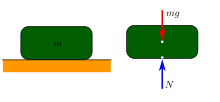
Back Meganiese ewewig Afrikaans توازن ميكانيكي Arabic Механічная раўнавага Byelorussian Механично равновесие Bulgarian मैकेनिकल इक्विलिब्रियम Bihari Equilibri mecànic Catalan Rovnovážná poloha Czech Mechanisches Gleichgewicht German Μηχανική ισορροπία Greek Meĥanika ekvilibro Esperanto

In classical mechanics, a particle is in mechanical equilibrium if the net force on that particle is zero.[1]: 39 By extension, a physical system made up of many parts is in mechanical equilibrium if the net force on each of its individual parts is zero.[1]: 45–46 [2]
In addition to defining mechanical equilibrium in terms of force, there are many alternative definitions for mechanical equilibrium which are all mathematically equivalent.
- In terms of momentum, a system is in equilibrium if the momentum of its parts is all constant.
- In terms of velocity, the system is in equilibrium if velocity is constant. * In a rotational mechanical equilibrium the angular momentum of the object is conserved and the net torque is zero.[2]
More generally in conservative systems, equilibrium is established at a point in configuration space where the gradient of the potential energy with respect to the generalized coordinates is zero.
If a particle in equilibrium has zero velocity, that particle is in static equilibrium.[3][4] Since all particles in equilibrium have constant velocity, it is always possible to find an inertial reference frame in which the particle is stationary with respect to the frame.
- ^ a b John L Synge & Byron A Griffith (1949). Principles of Mechanics (2nd ed.). McGraw-Hill.
- ^ a b Beer FP, Johnston ER, Mazurek DF, Cornell PJ, and Eisenberg, ER (2009). Vector Mechanics for Engineers: Statics and Dynamics (9th ed.). McGraw-Hill. p. 158.
{{cite book}}: CS1 maint: multiple names: authors list (link) - ^ Herbert Charles Corben & Philip Stehle (1994). Classical Mechanics (Reprint of 1960 second ed.). Courier Dover Publications. p. 113. ISBN 0-486-68063-0.
- ^ Lakshmana C. Rao; J. Lakshminarasimhan; Raju Sethuraman; Srinivasan M. Sivakumar (2004). Engineering Mechanics. PHI Learning Pvt. Ltd. p. 6. ISBN 81-203-2189-8.
© MMXXIII Rich X Search. We shall prevail. All rights reserved. Rich X Search